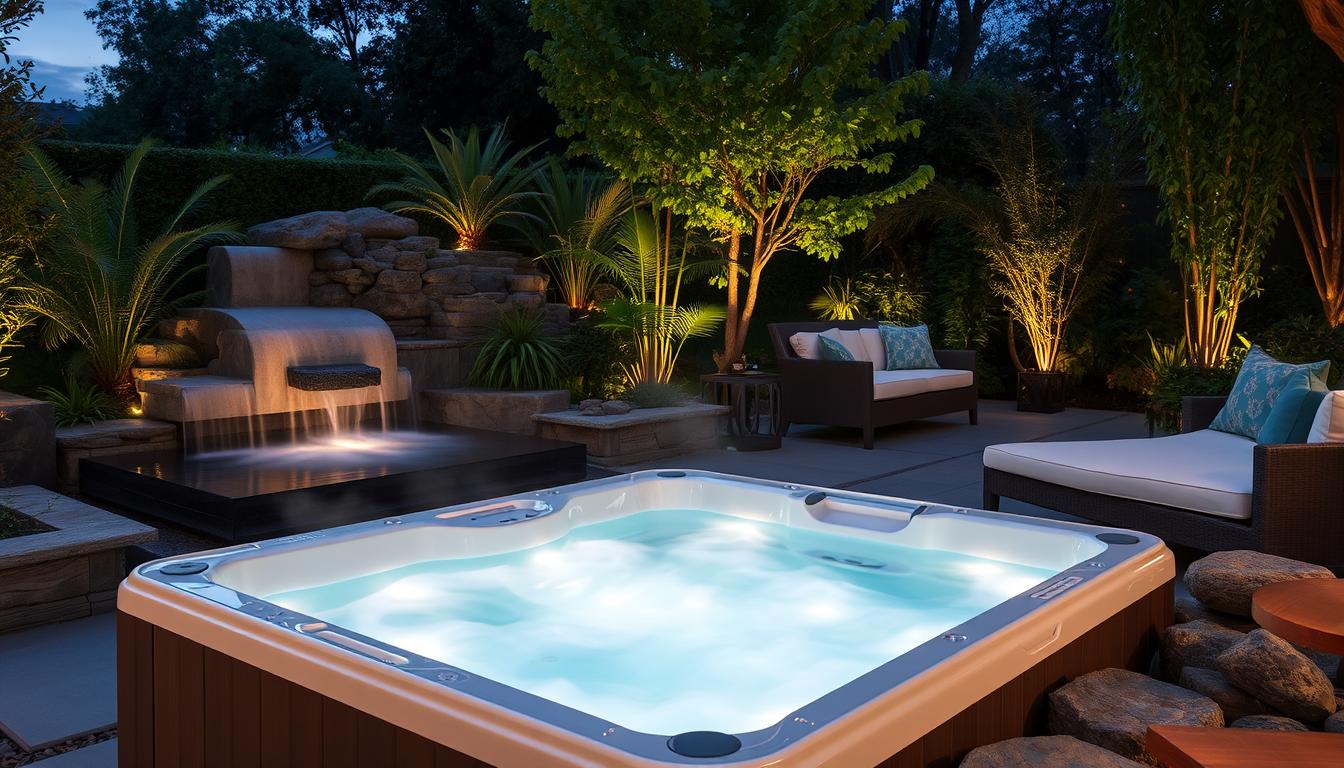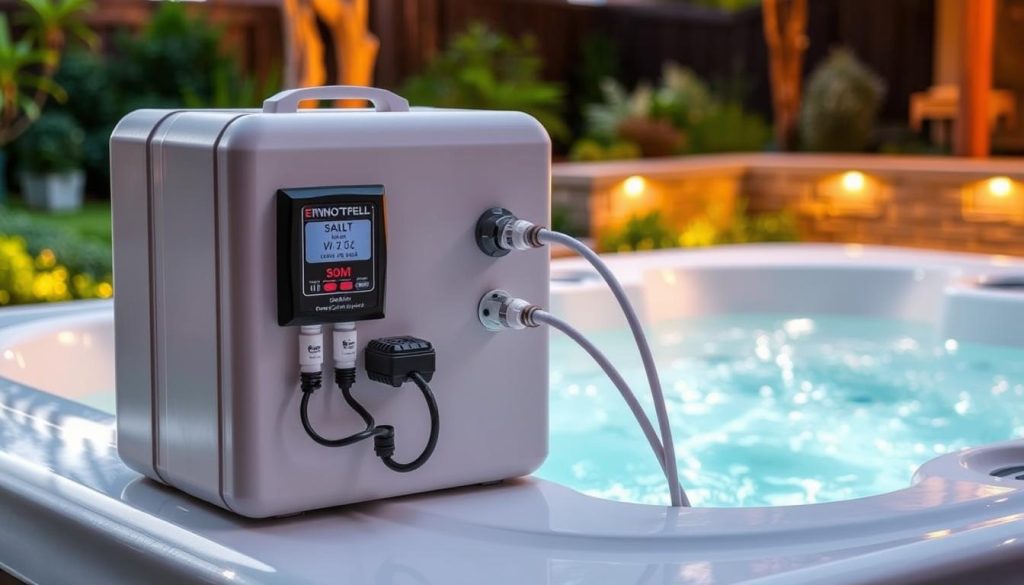
Imagine relaxing in a warm, soothing hot tub without harsh chlorine odors. Saltwater hot tubs offer a better way to enjoy your soak. They provide therapeutic benefits without the drawbacks of traditional chemical treatments.
Saltwater hot tubs use a process called electrolysis to create a sanitizing agent. This method keeps the water clean and clear. It’s gentler on your skin, eyes, and overall well-being than chlorine or bromine-based systems.
These innovative salt water therapy pools have gained popularity in recent years. They offer a more natural alternative to traditional hot tub sanitation methods.
This guide explores the world of salt water hot tubs. We’ll discuss their benefits and how they work. You’ll also learn how to convert your existing hot tub into a saltwater oasis.
Discover why more hot tub owners are switching to this revolutionary sanitation method. Let’s explore the question: “Can hot tubs be salt water?”
The Benefits of Converting Your Hot Tub to Salt Water
Salt water hot tubs offer many perks for a better soaking experience. They’re eco-friendly, low-maintenance, and gaining popularity fast. Users enjoy gentler effects on skin and fewer chemicals.
Gentler on Skin and Eyes
Salt water hot tubs are kinder to your skin and eyes. The water feels softer and silkier, reducing skin irritation and dryness. This makes them great for people with sensitive skin or conditions like eczema.
Reduced Chemical Usage and Costs
Salt water systems cut down on harsh chemicals. They use a generator to make chlorine naturally. This creates a healthier environment and saves money over time.
You’ll spend less on chemicals and enjoy a cleaner soak. The initial cost may be higher, but ongoing expenses are lower.
| Sanitizer | Initial Cost | Ongoing Costs | Maintenance |
|---|---|---|---|
| Salt Water | Higher | Lower | Less frequent chemical additions, monitoring salt levels |
| Chlorine | Lower | Higher | Regular chemical additions, monitoring chlorine levels |
| Bromine | Moderate | Moderate | Regular chemical additions, monitoring bromine levels |
Enhanced Therapeutic Effects
Salt water hot tubs boost therapeutic benefits with minerals like magnesium and potassium. These improve circulation, relax muscles, and promote overall well-being. Soaking in salt water can be more rejuvenating than traditional hot tubs.
“After converting our hot tub to salt water, we noticed an immediate difference in how our skin felt. It’s so much softer and less irritated now. Plus, we love knowing that we’re using fewer harsh chemicals.” – Sarah and John, salt water hot tub owners
Converting to salt water offers many benefits for your hot tub experience. You’ll enjoy gentler effects on skin, fewer chemicals, and enhanced relaxation. Make the switch for a more eco-friendly and enjoyable soak.
Understanding Salt Water Hot Tub Systems
Salt water chlorinators are key in converting hot tubs to salt water systems. They use electrolysis to create sanitizers from salt and water. This process keeps your hot tub clean and fresh.
Salt water systems need only an initial salt setup. The generator turns salt into chlorine or bromine, which cleans the water. Salt doesn’t evaporate, so you won’t need daily additions.
How Salt Water Chlorinators Work
The salt chlorine generator is the main part of your conversion kit. It uses electrolysis to make chlorine from salt. Simply add salt to the water, and the generator does the rest.
For best results, keep the right salt balance. Use about 2.5 pounds per 100 gallons of water. Check pH levels (7.2-7.8), alkalinity (80-120 ppm), and calcium hardness (150-250 ppm) regularly.
Drop-In vs. In-Line Salt Water Generators
There are two main types of salt water generators: drop-in and in-line systems. Drop-in systems are easier to use. They have a control panel and a cell you put in the water.
In-line systems need more setup. The cell connects to the hot tub’s plumbing. These systems are often for larger pools but can work for hot tubs too.
| System Type | Installation | Maintenance |
|---|---|---|
| Drop-In Salt System | Simple, submerge cell in water | Replace cartridge every 4 months |
| In-Line Salt System | Complex, requires plumbing connection | Professional maintenance recommended |
Regular upkeep is crucial for any salt water generator. Check chlorine levels daily (1-3 ppm). Rinse filters monthly and use test strips weekly.
With proper care, your salt water hot tub can offer a gentle, soothing soak. It’s a great way to relax and unwind.
Choosing the Right Salt Water Conversion Kit
Picking the right saltwater conversion kit is key for your hot tub. It ensures a smooth change and top performance. Consider factors like kit compatibility and included components.
Compatibility with Different Hot Tub Models
Check if the kit fits your hot tub model before buying. Look at manufacturer guidelines for the best match. Consider your tub’s size, brand, and current system.
A compatible kit avoids issues and gives the best results. This ensures your hot tub works well after conversion.

Essential Components for Conversion
A good hot tub saltwater conversion kit has several key parts. These work together to keep your water clean and healthy.
- Salt Chlorine Generator: This turns salt into chlorine. It cleans the water and reduces chemical use.
- Control Unit: This manages chlorine levels. It helps keep your water quality just right.
- Test Strips: These check salt levels and water balance. They give quick, accurate readings.
- pH Balancers: These keep pH levels correct. The ideal range is 7.2 to 7.8.
- Salt: Special salt is added to the water. It helps make chlorine. Soft tubs need 1,750-2,000 ppm, standard tubs 2,000-3,000 ppm.
- Owner’s Manual: This gives step-by-step setup instructions. It helps you maintain your new system easily.
| Brand | Lifespan (Hours) | Salinity Range (ppm) | Capacity (Gallons) | Warranty |
|---|---|---|---|---|
| Blue Works | 10,000 – 15,000 | – | – | – |
| Pentair | – | 2,800 – 4,500 | – | – |
| ControlOMatic | – | – | Up to 1,000 | – |
| Circupool | – | – | – | 4 years |
| Solaxx | – | – | Up to 20,000 | – |
Choose a kit that fits your tub and has all needed parts. This will help you create a relaxing saltwater oasis.
Your new system will offer a gentler, more refreshing soak. It’s a great upgrade for you and your guests.
Maintaining Your Salt Water Hot Tub
Keeping your salt water hot tub in top shape is easy with a regular routine. Balance salt levels and clean equipment for the best experience. Check salt levels and clean filters often.
Soft tubs need 1,750–2,000 ppm of salt. Standard tubs require 2,000–3,000 ppm. Always check your model’s manual for the right salt levels.
Use a saltwater test kit for accurate measurements. Monitor pH and sanitizing levels with test strips or a digital tester. Aim for a pH between 7.2 and 7.8.
Record your test results to spot trends over time. Do weekly shock treatments to remove contaminants and keep water clear.
Rinse filters every 2-4 weeks and deep clean them every few months. Clean the electrolytic cell quarterly to prevent buildup and maintain efficiency.
Follow these tips and use the right salt levels. You’ll enjoy a relaxing salt water hot tub for years to come.







